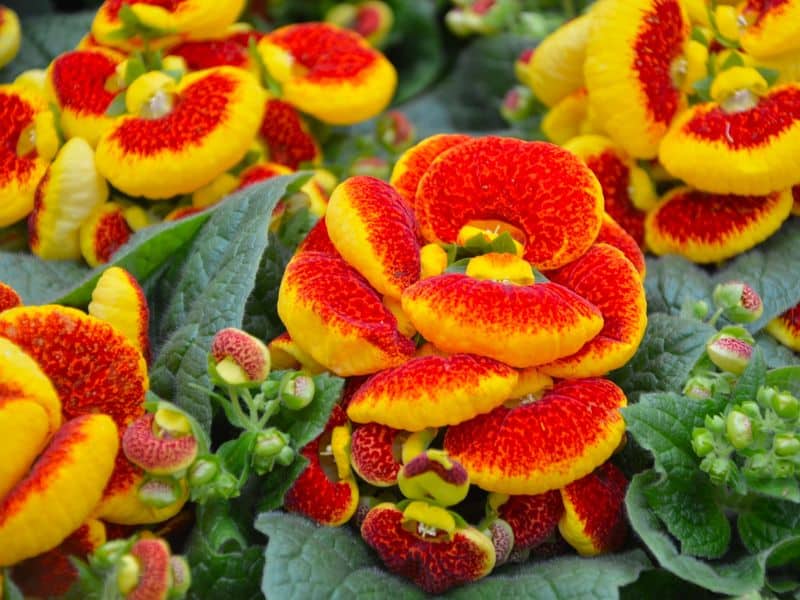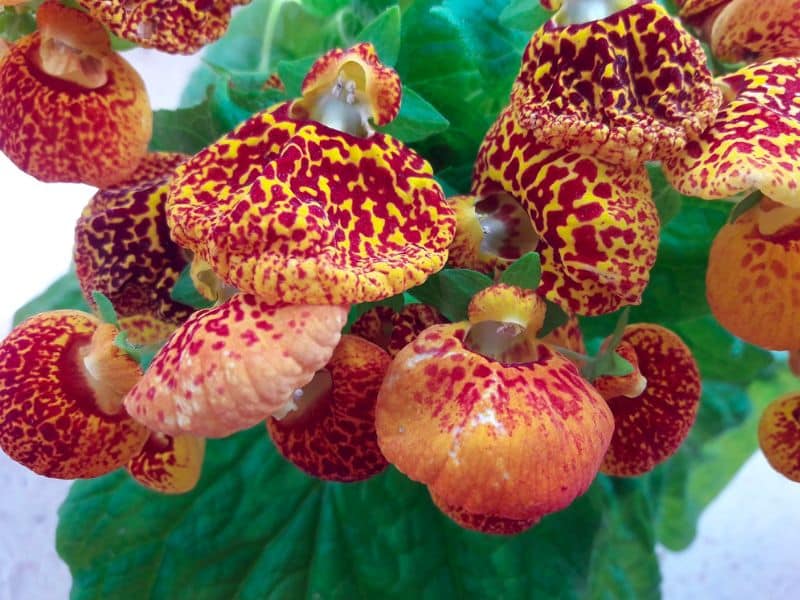Also known as the pocketbook plant, the pouch flower, slipperwort, and poor man’s orchid, calceolaria is a gorgeous herbaceous perennial that is often grown as a hardy annual.
Despite having a relatively demanding nature, this houseplant is worth the effort.
Although a pocketbook plant is often cultivated as a houseplant, it may also be utilized as an outdoor bedding plant. It is often grown as a greenhouse plant in northern growing zones but can also be grown in containers or even right out in the open provided that the conditions for its bright light, moisture, and temperature needs are met.
This plant has unusual, distinctive flowers that can be forced into bloom by specific actions on the part of the grower. The one-inch flowers have lower lips that look much like a pocketbook, as the name implies, in colors such as yellow, red, or orange.
If you’re interested in growing this curious, unusual-looking plant at home, follow these tips to learn how to grow and care for calceolaria – the pocketbook plant!
Plant Facts
| Scientific name | Calceolaria |
| Common names | Pocketbook plant, slipperwort, poor man’s orchid, pouch flower, lady’s purse, slipper flower |
| Family | Calceolariaceae |
| Plant Type | Houseplant |
| Height and Width | 1 ft. tall (indoors), 1 ft. wide (indoors) |
| Origin | Central and South America |
| Flower colors | Red, yellow, orange |
| Foliage color | Green |
| Sun Exposure | Bright, indirect sunlight |
| Soil Type & pH | Well-drained, moist, fertile soil |
| Special features | Good for containers, annual plant, good for balconies or patios, early spring flower |
How to Grow Calceolaria
This annual flower is small enough to be grown on patios, balconies, or in other small-space environments, but it’s also perfectly suited for growing in containers or directly in the flower beds. It looks smooch like an orchid and despite being equally difficult to care for, it offers a truly stunning display of color.
Propagation
The best way to propagate calceolaria is from seed. These seeds are very small so the easiest way to make sure they are spread evenly is to mix them with talc. Then, spread them on the surface of the soil. In addition to sowing seeds on a single tray filled with seed starting soil mixture, you can also sow them separately in peat tablets.
The best time to sow seeds is between July and November. Keep the seeds warm, at approximately 68 to 71 degrees Fahrenheit. They should germinate in ten days to several weeks. Once the plants have grown their second set of leaves you can divide the seedlings into individual pots that are at least three inches in diameter.
The seedlings can then be kept cool, at around 57 to 60 degrees Fahrenheit. You can transplant them outdoors or into their final containers when they are around three months old.
Calceolaria can also be propagated by cuttings. This should be done at the end of the summer. You can take root cuttings from new growth, which should happen after you remove the flower heads sometime between June and August.
Soil
The best soil for your calceolaria will be that which is loose and fertile. You can plant it in potting mix, compost, sand, perlite, or a combination of all of these substrates. Regardless of which type of soil you choose, make sure you grow your plant in a container with adequate drainage.
Pruning
Pruning is not necessary for this potted houseplant. However, you can remove damaged leaves and faded pentacles as they appear. When properly cared for, your calceolaria should flower for around one month. You can pinch the blooms back to keep the form of the plant and extend the bloom time.
You can also force the plant to bloom. To do this, you will need to drop the air temperatures to around 50 to 55 degrees Fahrenheit.
Repotting and Transplanting
Because calceolaria is generally grown as an annual, repotting is usually not necessary. However, if you purchase your calceolaria directly from the nursery, you may need to transplant it into a container that’s around six inches in diameter when it gets a bit older.
How to Care for Pocketbook Plant

Now that you know how, where, and when to plant calceolaria, here are some tips on how to best care for it to keep it healthy for years to come.
Water
Water your unusual flowers only when the top inch of potting soil is dry to the touch. Your plant will likely begin to wilt when it gets too dry (even just slightly dry) but it should perk back up as soon as you add some water.
Good drainage is important for the health and growth of your plant. Avoid watering too much – more than an inch or so of moisture each week can cause the plant to suffer from root rot.
Sunlight
Calceolaria should be grown in full sun or partial shade. It needs around six to seven hours of direct sun per day but can also tolerate a bit of morning shade and afternoon sun. If your plant does not receive enough indirect light or not direct sunlight, you may find that the blooms suffer in their quantity and color.
Moving your plant to shaded spots as the temperatures rise in the afternoon is a good way to prevent the blooms from wilting.
Temperature and Humidity
Calceolaria likes temperatures that are somewhat cool, though it’s certainly not a frost-tolerant plant. If temperatures drop below freezing, you should move it indoors until it gets warmer.
The slipper flowers also require a relatively high level of humidity. You may want to spray the air around the plant with a mister or bottle of warm water every now and then. Try not to wet the foliage when you do this, as it can lead to fungal diseases. Often, it is easier to simply place the plant’s container into a pan with a bit of damp peat moss instead.
Fertilizer
Feed your calceolaria plant with a fertilizer solution for houseplants during the active growing season between April and September. Use a fertilizer designed for annuals if possible, but if not, a general-purpose garden fertilizer should do the trick.
These pocketbook plants are not one that requires lots of fertilizer. However, you should double-check the product packaging to figure out how much fertilizer to use and how often. In general, just once a week with a balanced fertilizer is all you need.
Pest and Diseases
There are few pests and diseases to which this plant is prone. However, you will want to avoid conditions that are too warm or drafty, since this can encourage aphids to infest your plant.
Other issues that might affect your calceolaria include root and crown rot. Both of these are common when the soil remains too wet or when watering is inconsistent. The same can be said for gray mold, a fungal disease that doesn’t necessarily harm the plant but is unsightly to look at.
Some other pests to watch out for include whiteflies and spider mites. These can be removed with a bit of isopropyl alcohol.
Common Varieties and Cultivars

There are more than 300 different recognized species within the calceolaria genus. The most common types of Calceolaria are those in the Herbeohybrida group with other popular species including:
- Calceolaria adenanthera
- Calceolaria australia
- Calceolaria bentae
- Calceolaria brachiata
- Calceolaria commutata
- Calceolaria crenata
- Calceolaria crenatiflora
- Calceolaria hyssopifolia
- Calceolaria integrifolia
- Calceolaria lanata
FAQs
Is Calceolaria an outdoor plant?
Calceolaria, commonly known as slipper flower or pocketbook plant, is often grown as a houseplant rather than an outdoor plant. While it can be cultivated outdoors in certain climates, it is more commonly favored for indoor cultivation due to its specific temperature and humidity requirements.
Is Calceolaria an annual?
Calceolaria is typically grown as an annual, although in some regions with milder climates, it may behave as a short-lived perennial.
Is Calceolaria easy to grow?
Calceolaria can be somewhat challenging to grow as it requires specific conditions, including cool temperatures and high humidity. Adequate care, including maintaining the right environment and providing well-draining soil, is essential for successful cultivation.
What is the season for Calceolaria?
Calceolaria is generally a cool-season plant, and it blooms during the late winter to early spring months. It thrives in cooler temperatures and may struggle in summer heat conditions.
Conclusion
Calceolaria is a gorgeous annual houseplant that looks wonderful left to its own devices in a container. Of course, it will require a bit of attention from you, the gardener, every now and then!
Now that you know how to grow and care for calceolaria, all that’s left is to find the perfect species and cultivar to grow! As you can see, there are endless options to choose from.
*image by 1980monako/depositphotos







